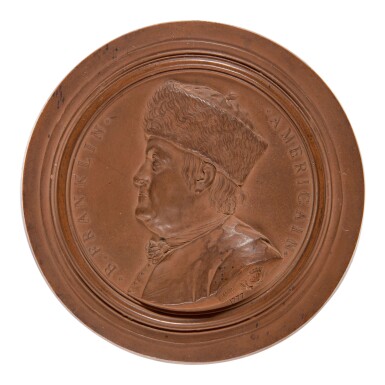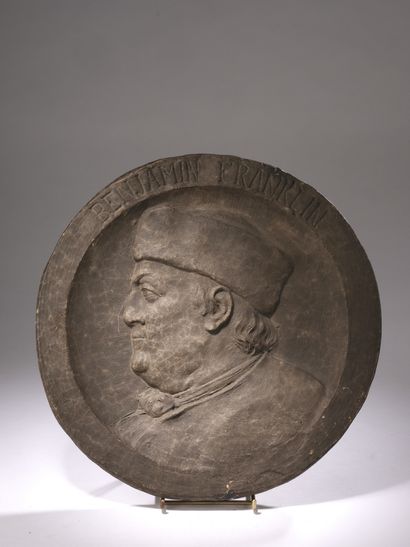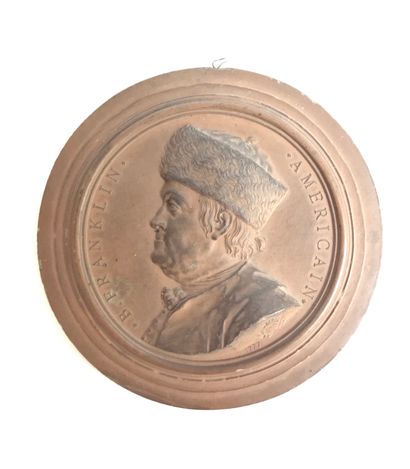FRANKLIN, Benjamin (1706-1790)]. -- NINI, Jean Baptiste (1717-1786). A PRELIMINARY MODEL FOR NINI'S TERRACOTTA PORTRAIT MEDALLION OF BENJAMIN FRANKLIN Chaumont-sur-Loire, France, circa 1777. 3½ inches diameter. -- [ With: ] The final version of the terracotta model. 4½ inches diameter.
FRANKLIN, Benjamin (1706-1790)]. -- NINI, Jean Baptiste (1717-1786). A PRELIMINARY MODEL FOR NINI'S TERRACOTTA PORTRAIT MEDALLION OF BENJAMIN FRANKLIN Chaumont-sur-Loire, France, circa 1777. 3½ inches diameter. -- [ With: ] The final version of the terracotta model. 4½ inches diameter. Benjamin Franklin was one of America's first ambassadors, although the United States did not officially exist, when he was sent to France in December of 1776 to seek French aid in support of the rebellion against England. One of his most important contacts and supporters was Jacques-Donatien Le Ray, who had established his fortune in shipping and operated an earthenware and glassmaking factory in Chaumont-sur-Loire. His friendship with Franklin was critical in winning French support for the American cause and Le Ray further assisted the American war effort in organizing and coordinating the American-French naval fleet, including the refitting of the warship USS Bonhomme Richard , used by Captain John Paul Jones. Le Ray commissioned the artist Jean-Baptiste Nini to create a terra-cotta relief portrait of Franklin which his perhaps his best known image. In June of 1779 Franklin wrote to his daughter Deborah in Philadelphia: "The clay medallion you say you gave to Mr. Hopkinson was the first of the kind made in France. A variety of others have been made since of different sizes; some to be set in the lids of snuffboxes, and some so small as to be worn in rings; and the numbers sold are incredible. These, with the pictures, busts, and prints, (of which copies upon copies are spread everywhere), have made your father's face as well known as that of the moon...It is said by learned etymologists, that the name doll, for the images children play with, is derived from the word IDOL. From the number of dolls now made of him, he may be truly said, in that sense, to be i-doll-ized in this country." The preliminary model shows Franklin in both eyeglasses and fur hat. Franklin's ever-present spectacles were as symbolic of the man to the French as was his fur hat, and an attempt was made to include them in the portrait. The spectacles also had political overtones as aristocrats did not wear them. The trial model was eventually rejected for, even though the eyes are not covered in the profile, an obscuring shadow is cast with light from the left-- confirming the incompatibility of spectacles with the form of this bust. It can be seen upon close inspection that this model is an entirely separate work, not a modified cast from a master mold. Benezit VI, p.367; Sellers Benjamin Franklin in Portraiture , pp. 103-105 and 343-347 (both the finished medallion "Nini: Walpole 1" and the preliminary model "Nini: Walpole 3" are described). (2)
FRANKLIN, Benjamin (1706-1790)]. -- NINI, Jean Baptiste (1717-1786). A PRELIMINARY MODEL FOR NINI'S TERRACOTTA PORTRAIT MEDALLION OF BENJAMIN FRANKLIN Chaumont-sur-Loire, France, circa 1777. 3½ inches diameter. -- [ With: ] The final version of the terracotta model. 4½ inches diameter.
FRANKLIN, Benjamin (1706-1790)]. -- NINI, Jean Baptiste (1717-1786). A PRELIMINARY MODEL FOR NINI'S TERRACOTTA PORTRAIT MEDALLION OF BENJAMIN FRANKLIN Chaumont-sur-Loire, France, circa 1777. 3½ inches diameter. -- [ With: ] The final version of the terracotta model. 4½ inches diameter. Benjamin Franklin was one of America's first ambassadors, although the United States did not officially exist, when he was sent to France in December of 1776 to seek French aid in support of the rebellion against England. One of his most important contacts and supporters was Jacques-Donatien Le Ray, who had established his fortune in shipping and operated an earthenware and glassmaking factory in Chaumont-sur-Loire. His friendship with Franklin was critical in winning French support for the American cause and Le Ray further assisted the American war effort in organizing and coordinating the American-French naval fleet, including the refitting of the warship USS Bonhomme Richard , used by Captain John Paul Jones. Le Ray commissioned the artist Jean-Baptiste Nini to create a terra-cotta relief portrait of Franklin which his perhaps his best known image. In June of 1779 Franklin wrote to his daughter Deborah in Philadelphia: "The clay medallion you say you gave to Mr. Hopkinson was the first of the kind made in France. A variety of others have been made since of different sizes; some to be set in the lids of snuffboxes, and some so small as to be worn in rings; and the numbers sold are incredible. These, with the pictures, busts, and prints, (of which copies upon copies are spread everywhere), have made your father's face as well known as that of the moon...It is said by learned etymologists, that the name doll, for the images children play with, is derived from the word IDOL. From the number of dolls now made of him, he may be truly said, in that sense, to be i-doll-ized in this country." The preliminary model shows Franklin in both eyeglasses and fur hat. Franklin's ever-present spectacles were as symbolic of the man to the French as was his fur hat, and an attempt was made to include them in the portrait. The spectacles also had political overtones as aristocrats did not wear them. The trial model was eventually rejected for, even though the eyes are not covered in the profile, an obscuring shadow is cast with light from the left-- confirming the incompatibility of spectacles with the form of this bust. It can be seen upon close inspection that this model is an entirely separate work, not a modified cast from a master mold. Benezit VI, p.367; Sellers Benjamin Franklin in Portraiture , pp. 103-105 and 343-347 (both the finished medallion "Nini: Walpole 1" and the preliminary model "Nini: Walpole 3" are described). (2)








.jpg)






Try LotSearch and its premium features for 7 days - without any costs!
Be notified automatically about new items in upcoming auctions.
Create an alert